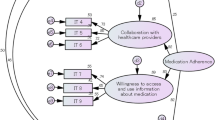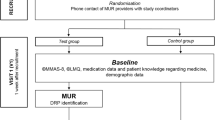Abstract
Background The previous Thai version of the 8-item Morisky Medication Adherence Scale (8-item MMAS) showed poor sensitivity and unacceptable internal consistency reliability. Objectives To develop and test the psychometric properties of a new medication taking behavior measure for Thai patients (MTB-Thai) including practicality, reliability and validity. Methods This study was conducted with adult outpatients regularly taking any medicines for at least three months from three university hospitals in Bangkok, Thailand, between July 2014 and March 2015. The study was approved by the Ethical Committees of the three hospitals. Practicality was assessed by administration time and the percentage of missing data. Internal consistency and test–retest reliability were evaluated employing Cronbach’s alpha and intraclass correlation coefficients (ICCs), respectively. Validity was evaluated with content, construct, convergent and known-groups validity. Results Of 1156 patients, the 6-item MTB-Thai had an average administration time of 2 min and no missing data. It showed good Cronbach’s alpha value of 0.76 and excellent ICCs of 0.83. The MTB-Thai showed good content validity with the item level and scale level of content validity indexes greater than the acceptable levels of 0.8 and 0.9, respectively. Both exploratory and confirmatory factor analyses showed the MTB-Thai had two domains including unintentional and intentional domains. The MTB-Thai correlated well with the overall medication adherence scale with a Pearson’s correlation coefficient of 0.62 (p < 0.001). The sensitivity, specificity, positive predictive value and negative predictive value of the MTB-Thai were 76, 35, 55 and 57 %, respectively. Conclusion The MTB-Thai was practical, reliable and valid in assessing mediation taking behaviors in Thai patients with chronic diseases.
Similar content being viewed by others
References
Cipolle RJ, Strand LM, Morley PC. Pharmaceutical care practice: the clinician’s guide. 2nd ed. New York: McGraw-Hill; 2004. p. 188–91. ISBN 0071362592
Dimatteo MR. variation in patients’ adherence to medical recommendations: a quantitative review of 50 years of research. Med Care. 2004;42:200–9
Haynes RB, Montague P, Oliver T, McKibbon KA, Brouwers MC, Kanani R. Interventions for helping patients to follow prescriptions for medications. Cochrane Database Syst Rev. 2002;2:CD000011
Iuga OA, McGuire MJ. Adherence and health care cost. Risk Manag Healthc Policy. 2014;7:35–44
Osterberg L, Blaschke T. Adherence to medication. N Eng J Med. 2005;353:487–97
Vik SA, Maxwell CJ, Hogan DB. Measurement, correlates, and health outcomes of medication adherence among seniors. Ann Pharmacother. 2004;38:303–12
Morisky DE, Ang A, Krousel-Wood M, Ward H. Predictive validity of a medication adherence measure for hypertension control. J Clin Hypertens. 2008;10:348–54
Sakthong P, Chabunthom R, Sakulbumrungsil R. Psychometric properties of the Thai version of the 8-item Morisky Medication Adherence Scale in patients with type 2 diabetes. Ann Pharmacother. 2009;43:950–7
Nunnally JC Jr. Psychometric theory. 3rd ed. New York: McGraw-Hill; 1994. ISBN 007047849X
Renberg T, Lindblad AK, Tulley MP. Testing the validity of a translated pharmaceutical therapy-related quality of life instrument, using qualitative ‘think aloud’ methodology. J Clin Pharm Ther. 2008;33:279–87
Granas AG, Norgaard LS, Sporrong SK. Lost in translation? Comparing three Scandinavian translations of the Beliefs about Medicines Questionnaire. Patient Educ Couns. 2014;96:216–21
Chinda M, Jaturapatporn D, Kirshen AJ, Udomsubpayakul U. Reliability and validity of a Thai version of the Edmonton Symptom Assessment Scale (ESAS-Thai). J Pain Symptom Manag. 2011;42:954–60
World Health Organization. Adherence to long-term therapies: evidence for action. 1st ed. Sabate E, ed. Geneva: WHO Publications; 2003. ISBN 9241545992
US Department of Health and Human Services, Food and Drug Administration. Guidance for industry: patient-reported outcome measures: use in medical product development to support labeling claims 2009. http://www.fda.gov/downloads/Drugs/Guidances/UCM193282.pdf. Accessed 13 Nov 2015
Valiganker JA, Subramaniam M, Chong SA, Abdin E, Edelen MO, Picco L, et al. The positive mental health instrument; development and validation of a culturally relevant scale in a multi-ethnic Asian population. HQLO. 2011;9:92
Lynn MR. Determination and quantification of content validity. Nurs Res. 1986;35:382–5
Jaccard J, Wan CK. LISREL approaches to interaction effects in multiple regression. Thousand Oaks: Sage; 1996. ISBN 0803971796
Fan X, Thompson B, Wang L. Effects of sample size, estimation method, and model specification on structural equation modeling fit indexes. Struct Equ Model. 1999;6:56–83
Rumsey DJ. Statistics II for dummies. 2nd ed. Indianapolis: Wiley; 2009. ISBN 0470466464
Rothman KJ. Epidemiology: an introduction. New York: Oxford University Press; 2002. ISBN 0195135539
Rosner B. Fundamental of biostatistics. 5th ed. Pacific Grove: Duxbury Thomson Learning; 2000. ISBN 0534370683
Tandon S, Chew M, Eklu-Gadegbeku CK, Shermock KM, Morisky DE. Validation and psychometric properties of the 8-item Morisky Medication Adherence Scale (MMAS-8) in Type 2 diabetes patients in sub-Saharan Africa. Diabetes Res Clin Pract. 2015. doi:10.1016/j.diabres.2015.10.001
Arnet I, Metaxas C, Walter PN, Morisky DE, Hesberger KE. The 8-item Morisky Medication Adherence Scale translated in German and validated against objective and subjective polypharmacy adherence measures in cardiovascular patients. J Eval Clin Pract. 2015;21:271–7
De Oliveira-Filho AD, Morisky DE, Neves SJF, Costa FA, de Lyra Junior DP. The8-item Morisky Medication Adherence Scale: Validation of a Brazilian-Portuguese version in hypertensive adults. Res Soc Admin Pharm. 2014;10:554–61
Moharamzad Y, Saadat H, Shahraki BN, Rai A, Saadat Z, Aerab-Sheibani H, et al. Validation of the Persian version of the 8-item Morisky Medication Adherence Scale (MMAS-8) in Iranian hypertensive patients. Glob J Health Sci. 2015;7:173–83
Savoldelli VK, Gillaizeau F, Pouchot J, Lenain E, Postel-Vinay N, Plouin PF, et al. Validation of a French version of The8-item Morisky Medication Adherence Scale in hypertensive adults. J Clin Hypertens. 2012;14:429–34
Kim JH, Lee WY, Hong YP, Ryu WS, Lee KJ, Lee WS, et al. Psychometric properties of a short-reported measure of medication adherence among patients with hypertension treated in a busy clinical setting in Korea. J Epidemiol. 2014;24:132–40
Yan J, You LM, Yang Q, Liu B, Jin S, Zhou J, et al. Translation and validation of a Chinese version of the 8-item Morisky medication adherence scale in myocardial infarction patients. J Eval Clin Pract. 2014;20:311–7
Neuman WL. Social research methods: qualitative and quantitative approaches. 3rd ed. Boston: Allyn & Bacon; 1997. ISBN 0205193560
Acknowledgments
The authors would like to thank all patients for their participation in the study, the hospital staff for assistance with the data collection, and Dr. Win Winit-Watjana and Dr. Stephen Pinder for kind help to edit the manuscript.
Funding
This study was funded by Thailand Research Fund, Chulalongkorn University and Faculty of Pharmaceutical Sciences, Chulalongkorn University (Grant Number: RSA 5580035).
Author information
Authors and Affiliations
Corresponding author
Ethics declarations
Conflicts of interest
The authors do not have any conflicts of interest to declare.
Rights and permissions
About this article
Cite this article
Sakthong, P., Sonsa-Ardjit, N., Sukarnjanaset, P. et al. Development and psychometric testing of the medication taking behavior tool in Thai patients. Int J Clin Pharm 38, 438–445 (2016). https://doi.org/10.1007/s11096-016-0275-8
Received:
Accepted:
Published:
Issue Date:
DOI: https://doi.org/10.1007/s11096-016-0275-8




